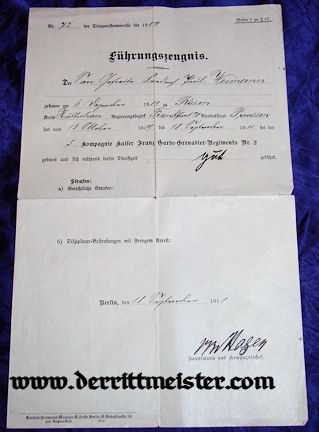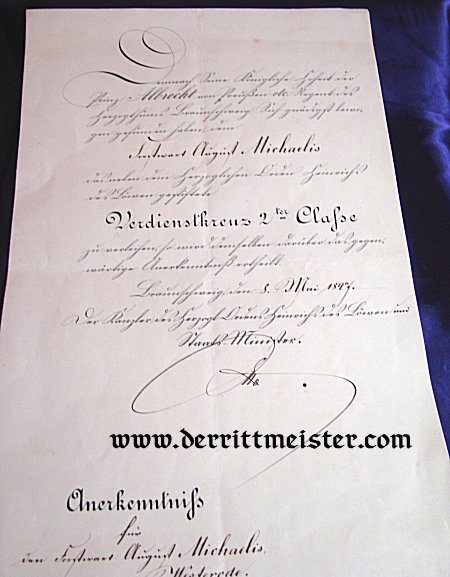Description
This is a confirmation-of-service document for a One-Year-Volunteer (OYV) who served in the Grand Duchy of Baden’s 5. Badisches Infanterie-Regiment Nr 113. The regiment was founded in 1861 and garrisoned at Freiburg I, B. The regiment was attached to the XIV. Armeekorps. The soldier was named Emil Burkhardt. He served in the regiment’s 11th Kompagnie. He was born in 1882 and first joined the regiment in 1904. In 1912 he transferred to a Württemberg regiment, Grenadier-Regiment König Karl (5. Württ.) Nr 123, serving in its 10th Kompagnie. This proud old regiment was raised in 1799 and garrisoned at Ulm, where it was attached to the XIII. Armeekorps.
The normal enlistment in the German Army was for two years. The government assumed all expenses for the soldiers and provided them with food, housing, as well as all clothing and gear associated with their assignment. The OYV program was quite different. As the name implies, OYV’s voluntarily joined the army for a period of one year. These men generally came from wealthier families, although usually not from nobility. They had the money, however, to assume all responsibility for their own maintenance as soldiers. They not only took care of their own food and housing, but all of their clothing. In acknowledgment of this responsibility, the Army allowed them a bit of freedom with their uniforms and headdress.
Generally these young men went to the same stores as officers to purchase their uniforms and dress headdress. Their uniform shoulder straps sported unique rope-like braid-bands that encircled the straps’ edges. The rope-like trim displayed the regiment’s state colors, which clearly stood out. When it came to pickelhauben for OYV’s like Herr Burkhardt, they were allowed to wear ones that were almost the same as their officers. The only rule was that an OYV’s helmet had to have one or more aspects that were different from officers and more like those worn by NCO’s or enlisted men. The one thing they could NOT copy was the officers stars. They often had wappens with voided crowns that were identical to those sported by officers.
After an OYV completed his enlistment, he entered the reserves, as did the two-year enlistees. He was then required to perform an annual duty with the regiment (similar to the American National Guard) and was subject to recall based on the needs of the service. In the reserves, OYV’s often rose to NCO status quite quickly. It was also common for them to be promoted to the Leutnant der Reserve ranks. [Many men assumed this rank when WW I began].
The document, which measures 8 ” x 12,”was signed in December 1912 by a regiment official. [It is interesting to note that Burkhardt was thirty-years-old in 1912, which made him thirty-two when WW I broke out]. It has been folded and has two punch holes where it was placed in a file. That said, the document is in very fine condition.








